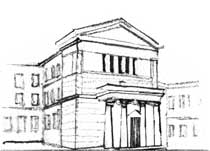Exact Results in Quantum Theory
2006/2007 | 2007/2008 | 2008/2009 | 2009/2010 | 2010/2011 | 2011/2012 | 2012/2013 | 2013/2014 | 2014/2015 | 2015/2016 | 2016/2017 | 2017/2018 | 2018/2019 | 2019/2020 | 2020/2021 | 2021/2022 | 2022/2023 | 2023/2024 | 2024/2025 | Seminar homepage
2010-05-28 (Friday)
Adam Latosiński (IFT UW)
Nonperturbative effects in gauge theories
2010-05-14 (Friday)
Michał Dziendzikowski (IFT UW)
Background independent quantizations: point polymer quantization of real vector fields
Loop Quantum Gravity is one of the most prominent examples of a quantum theory where elementary variables are polymerlike, i.e. supported on submanifolds of lower dimension than the space manifold of a theory. Therefore similar background independent framework of quantization was needed to matter fields, e.g. scalar field. At first momentum space representation for scalar field was provided in which operators corresponding to momenta are diagonal and field operators exist only in the exponentiated form. Later the modification of this framework, i.e. position space representation was used to address the issue of quantum resolution of black hole singularities in the spherically symmetric part of gravitational phase space. In this talk the generalization of these frameworks to real vector fields will be presented.
2010-05-07 (Friday)
Antonio Vassallo
Spacetime Substantivalism and General Relativity. Why four dimensions are probably not enough
In this talk I will argue that, within General Relativity, spacetime has an ambiguous ontological status due to a flawed or incomplete description. In the end, I will consider a generalization of the theory that seems to mitigate the problem.
2010-04-30 (Friday)
Frank Hellmann (University of Nottingham)
TQFTs, State Sums and Geometry, part II
I review the state sum definition of TQFTs and show in which contexts Geometry can arise in these.
2010-04-23 (Friday)
Frank Hellmann (University of Nottingham)
TQFTs, State Sums and Geometry
I review the state sum definition of TQFTs and show in which contexts Geometry can arise in these.
2010-04-16 (Friday)
Marcin Kisielowski (IFT UW)
The EPRL Spinfoam Model, part II
2010-04-09 (Friday)
Marcin Kisielowski (IFT UW)
The EPRL Spinfoam Model
2010-03-26 (Friday)
Michał Wrochna (KMMF UW)
Holomorphic families of Shroedinger operators
The concept of analytic functions with values in unbounded operators was first motivated by perturbation theory in quantum mechanics. It has led to considerable results valuable in this particular context. Recent results show it plays an independent role in describing other properties of Schroedinger operators. This motivates the need for a more general mathematical theory, involving surprising features.
2010-03-19 (Friday)
Michał Wrochna (KMMF UW)
Decay rates in QED
In the literature, various methods are used to compute decay rates of excited states in QED. In the simpliest cases, lower-rank calculations motivate the belief that they lead to the same results. However, there is no such evidency in general and it is not even clear if the most common method is adequate from a conceptual point of view. We will discuss the problem on the example of two-photon decay processes in the excited hydrogen atom. In particular. we will make use of the Gell-Mann, Low and Sucher formula and compare it with alternative approaches.
2010-03-12 (Friday)
Przemysław Malkiewicz (IPJ)
Reduced phase space quantization applied to cosmology
I will use an alternative method, so called reduced phase space quantization, to construct a quantum theory of flat FRW universe with massless scalar field. The spectra of volume and energy density operators will be presented. Then, I will show how to apply these results to Bianchi I universe.
2010-02-19 (Friday)
Marcin Kaźmierczak (IFT UW)
Quantum fields corresponding to faithful representations of the Poincare group and Poincare gauge theory of gravity II
2010-01-22 (Friday)
Catherine Meusburger (Department of Mathematics, University of Hamburg)
Quantum group and Hopf algebra symmetries in (2+1)-gravity
We discuss the role of quantum group and Hopf algebra symmetries in (2+1)-gravity. In particular, we comment on the question which quantum groups are relevant for (2+1)-gravity and show that quantum group symmetries are also present in (2+1)-dimensional loop quantum gravity. Part of thhe talk is based on joint work with K. Noui and B. J. Schroers.
2010-01-08 (Friday)
Bianca Dittrich (MPI, Albert Einstein Institute)
Canonical kinematics and dynamics for simplicial geometries
2009-12-18 (Friday)
Piotr Sulkowski
New connections between two- and four-dimensional quantum field theories
This year remarkable relations have been discovered between four-dimensional, supersymmetric quantum gauge theories, andtwo-dimensional conformal field theories. As it turns out, various exact quantities computed for certain theories in both these classes are equal to each other. These quantities include four-dimensional partition functions on one hand, and two-dimensional correlators (three-point functions, conformal blocks) on the other hand. There is a growing computational and conceptual evidence that these relations are true in a very general context. I will discuss how this conjecture could be proved by relating both classes of theories in question to matrix models and non-commutative Riemann surfaces, and sketch the associated string theory interpretation.
2009-12-04 (Friday)
Ewa Infeld (IFT UW)
Group Field Theory
2009-11-27 (Friday)
Michele Arzano
Fun from none: deformed Fock space and hidden entanglement
Attempts to go beyond the framework of local quantum field theory include scenarios in which the action of external symmetries on the quantum fields Hilbert space is deformed. A common feature of these models is that the quantum group symmetry of their Hilbert spaces induces additional structure in the multiparticle states which in turns reflects a non-trivial momentum-dependent statistics. In certain particular models which might be relevant for quantum gravity the richer structure of the deformed Fock space allows for the possibility of entanglement between the field modes and certain ''planckian'' degrees of freedom invisible to an observer that cannot probe the Planck scale.
2009-11-20 (Friday)
Andrzej Herdegen
Electrically charged quantum particles: a C*-algebraic model
Charged particles cannot be separated from the electromagnetic field surrounding them and, when scattered, they produce long-range radiation. Related to these experimental facts are difficulties in the mathematical modelling of elementary particles like electrons.
A C*-algebraic model of electrons and radiation will be discussed. It avoids the complexity of the full theory, but allows the study of the "dressing" of electrons with the electromagnetic field by an analysis of its representations.
2009-11-13 (Friday)
Marcin Kazmierczak
Quantum fields corresponding to faithful representations of the Poincare group and Poincare gauge theory of gravity
In standard quantum field theory, the Hilbert spaces of one-particle states correspond to irreducible unitary representations of the universal covering of the Poincare group, whereas quantum fields are classified by finite-dimensional representations of the universal covering of the Lorentz group. For a given field, these representations need to be connected vie Weinberg consistency conditions. I will investigate the possibility of using finite-dimensional faithful representations of the Poincare group to classify quantum fields. Is it possible to develop a consistent theory of the associated particles? If yes, will they differ from standard ones? This questions will be addressed.
I will also consider the inclusion of gravity, interpreted as a gauge theory of the Poincare group, to the field theories constructed in thisway. The new feature is that the translational gauge fields enter the covariant derivative of matter fields. Also, the so called Poincarecoordinates, that are normally hidden within the cotetrad (together with translational gauge fields) will now manifest themselves explicitly.







